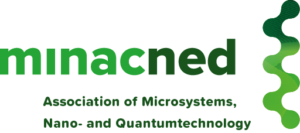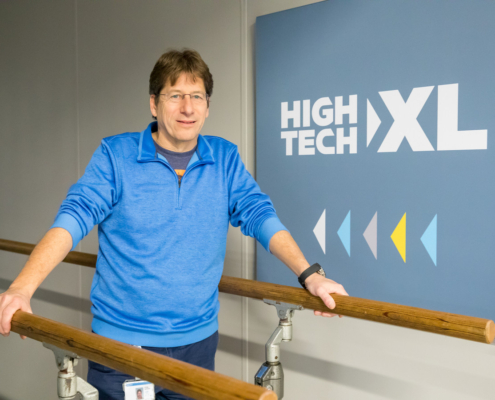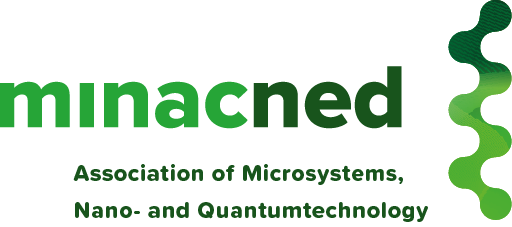Eindhoven University of Technology’s innovative learning environment, innovation Space, has been nominated for the Dutch Higher Education Prize. The award ceremony will be held on March 1.
CORINE SPAANS
“I learned from the outset how to make a prototype.” “The instructor gave me the confidence to try out my ideas.” “The teachers motivated us to go even further than we ever thought possible before we took the course.” These are just a few quotes from an evaluation of courses at Innovation Space. An open community where students, student teams, student entrepreneurs and researchers work in interdisciplinary teams together with businesses and civil society organizations on the challenges of today and the future. Innovation Space is a finalist along with the Urban Futures Studio from Utrecht University and the ‘Re-imagining Tomorrow through Arts and Sciences’ minor from Erasmus University.
Innovation in education
This new education award serves as a great token of appreciation for teacher teams that are achieving outstanding results. According to the website of the Dutch government, it also motivates teachers to continue with innovation in education and knowledge sharing. TU/e innovation Space is to receive half a million euros in prize money. That amount could rise even further to 1.2 million euros once the Minister of Education, Culture & Science announces on March 1 who is in first, second and third place.
“It’s a national acknowledgement of what we have been working on for the past five years,” says Professor Isabelle Reymen proudly. She and two other faculty members were at the forefront of what has grown into the student community that it is today. “Five years, ago we started out very small with two or three courses.” Meanwhile, 2200 students take 38 courses there, the teaching team has grown to 27 teachers in charge and 120 teachers are involved.
Creating impact
There were two main reasons driving innovation in education, Reymen explains. “We are dealing with a different generation of students. They really want to create impact, to improve the world.” At first she thought it was one student who wanted to graduate in Sustainable Energy, “but no, it was one after another. You have to offer education to these students in a different way. By addressing their passion and challenging them.”
As the second reason, Reymen cites industry, in particular, the Brainport region, which she says: “Just craves different kinds of employees. Engineers of the future who can really work together in interdisciplinary teams, have an entrepreneurial attitude and are able to think on a systems level.”
Reymen and her colleagues drew inspiration from abroad. “We combined that with our experiences with the student teams that we already had. Even though students don’t gain any study credits for that, you could just see that students there were working on what they are passionate about and learning a lot.”
World Champions
For instance, Team Solar built a car that runs on solar energy. The team became world champions four times in Australia. “That’s just fantastic, those students learn an awful lot. Not only about working together, but also about applying that battery technology in the real world. They used the know-how they learned and all that new knowledge and insights, because they wanted to become world champions, of course.”
Challenge-Based Learning forms the basis of the learning environment. With this, students work on relevant social problems for challenge-owners from the field. “Real-life clients for whom the students come up with a solution.” They work together on that solution from a variety of disciplines. Where applicable, they build a prototype and reflect on their work together.
Reymen herself teaches a course on innovation and entrepreneurship, the Innovation Space Project. “When you see what students learn in six months – that’s how long a course takes – it’s amazing. They have done something that they would never have thought possible. The self-confidence they gain from that is wonderful to see.” In addition to the courses, there are also activities that students do not receive any study credits for, such as the student teams. “There, too, you see students are really thriving and accomplishing some truly amazing things.”
Learning from each other
As did industrial design student Tom Cobbenhagen, who completed a Master’s project. He flourished due to the multidisciplinary nature of the curriculum. “What often happens at a university, and certainly at a technical one, is that people tend to stick to their own field. As a result, they come into less contact with other disciplines. It is precisely because you are thrown into a group here with all sorts of different backgrounds that you can combine those strengths. There is much more room to learn from each other. I didn’t end up deepening my studies, but actually broadening them. We learned to create an impact for the challenge owner – Eindhoven Airport. And its social goals: a solution to the mobility problem.”
Read more about the activities at TU/e innovation Space here.
Looking back, Reymen finds it “really wonderful that with a relatively small team, we can still make a major structural change in education at TU/e happen.” “I am most proud of the fact that we succeeded in doing that.”
The prize money has already been allocated. Reymen will use the money in any event to invest in a wider range of courses, “so that more students can come into contact with Challenge-Based Learning.” To that end, she wants to develop training courses for teachers to help them deal with challenge owners and coach them properly. “Also, we want to offer more choice in the courses and themes that students are interested in. Right now, we are still working on a course level; in time, we would really like to be able to give students an individual learning path.”
Working together with other schools
One example is an online platform so that students from different schools and universities in the Netherlands and Europe can work together on challenges. “We already work together with Fontys and with the four technical universities in the Netherlands and we are active in European Alliances. If you really want students to work together, you have to be able to do that very effectively online, because you’re not all in the same place at the same time.”
Should Innovation Space win the top prize, Reymen will be looking further into the future and envisioning innovative ecosystems. “At the moment, we are still taking on challenges ad hoc. We want to see if we can set up long-term partnerships so that we can work together in a more structural way with multiple partners. For example, a Sustainable Energy learning line, where citizens work with companies, and governments work with students and cross-disciplinary research groups at Eindhoven University of Technology.”
At the end of the second Comenius Festival on March 1, the Minister of Education, Culture & Science, Ingrid van Engelshoven, will award the first Dutch Higher Education Prize.
Source: Innovation Origins


